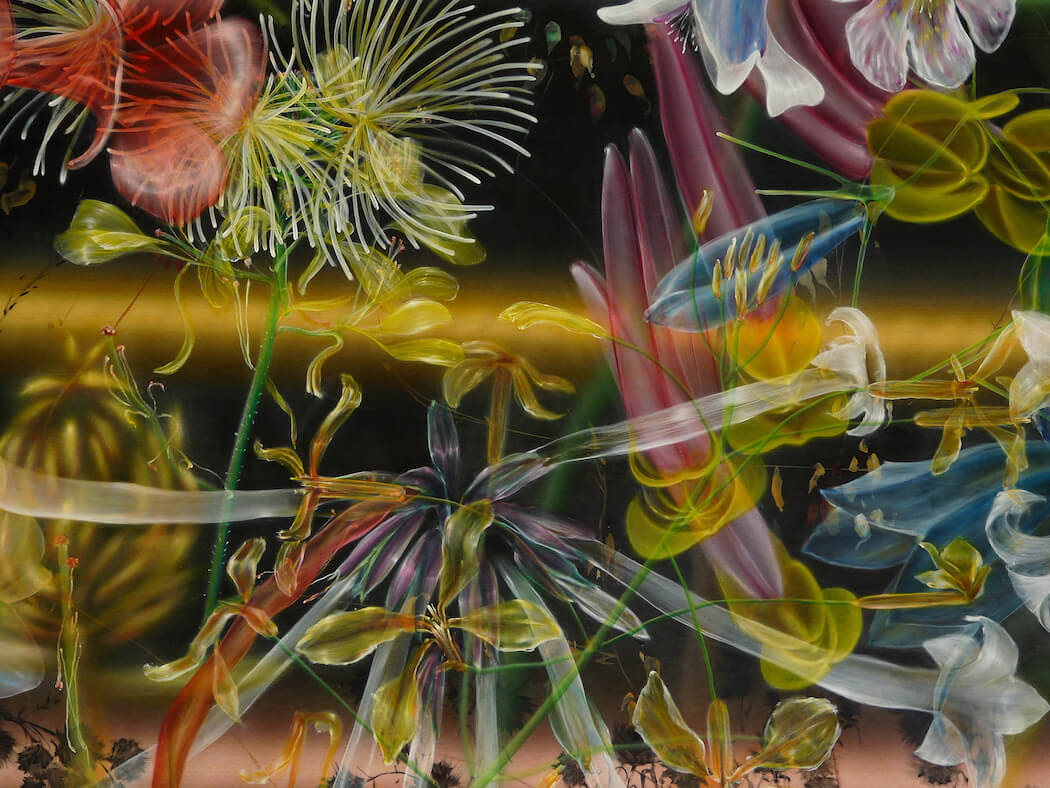To be perfectly candid, I nearly called this interview Limbo n*5. Hervé Ic’s paintings are the perfect illustration of eerie, they possess a diaphanous hazy charm sending the viewer in a parallel dimension. The world that seems the closest would be lost in time, around the ’70s maybe, thanks to a palette gathering browns and oranges. Immediately, one can only marvel at the transparency of the objects, a true ode to what painting is capable of. The brushwork is so discreet as if the painter himself was not the habitant of a physical body, but an ethereal being that caressed the surface and painted directly with memories. Let’s immerse a bit deeper in the layers as Hervé Ic was kind enough to answer my questions.
www.herveic.com Instagram @hervegeorgesic
the light in our eyes
KB: How do you start your day?
I’m going to the studio to see if the canvas moved overnight. I try to find the intuitions of the day before, evaluate what I have done and decided the next step with fresh eyes.
Then I prepare the son’s chocolate.


Light effects: infinite variations of the same, cosmic reflections, ontological metaphor.
KB: Do you like exhibiting your work?
No, but it’s a necessity.
KB: What do you do on the openings?
A buffet with good wine and beer, that my friends feel at home and stay late.


KB: What is your favourite place to think about a new painting?
The train, the countryside, nature. Everything that lies far from the studio, invoices and constraints.
KB: What is your relation to past painters, and history of art?
Excellent. I try to understand them without imitating them. They always have things to teach me.
KB: Which question would you like to ask your painting Idol?
How to close the loop?


KB: How did you develop this work you’re doing now?
I never betrayed myself. There was no break between childhood and today, it’s a continuity that pushes the same questions a little further.
KB: How did you meet your favourite collector?
Like all encounters; by chance and without strategic intent. Calculation distorts relationships. A river flows by unfolding its topological curves, otherwise, it is a channel that does not bring life.
KB: Why do we still paint in 2020?
Because painting is an irreplaceable primary technique for figuring thoughts, like writing and music. One would have to stop thinking to stop painting. It can still happen.
KB: Where is Painting heading?
Nowhere. It follows us walking in front, like the shadow of the sun in the back. The painting also exists for crusts and tragic mistakes.
KB: Can you tell me 3 colleagues whose work you admire?
Helène Delprat, Thomas Fougeirol, Fabien Boitard, Vanessa Fanuel.
KB: Thank you Hervé, and thank you, reader.
All images belong to the Artist.


BIOGRAPHY:
Hervé Ic is a French painter born in 1970 in Paris. He lives and works in Brussels. He studied image technology and artificial intelligence applied to the image (DEA IARFA) at the universities of Paris VIII and Paris VI until 1996, then devoted himself exclusively to painting.
He exhibited at the Espace Paul Ricard in Paris in 1998; at the Valérie Cueto gallery in 2002; at the Creux de l’Enfer, contemporary art centre in Thiers in 2007; at the Iragui Gallery in Moscow in 2009 and 2013; at the Mircher gallery in Paris in 2010; at the art centre Le LAIT d’Albi by J.R. Meyer in 2014; at the Aéroplastics gallery in 2017 in Brussels.
His works were presented at the Fine Arts Museum in Tourcoing with ADIAF in 2004, at the Art Museum of Sao Paolo (MASP) and Porto Alegre (MARGS) in the curatorial office of Eric Corne A Century of Realism in French Painting, from Courbet to Narrative Figuration, 1865-1965 in 2009; at the Perm Art Museum (PERMM) by A. Fau and N. Audureau curators of The Contemporary French Painting. Combinations of history in 2012; with the Charles Riva Collection by Pierre-Yves Desaive, for the exhibition The Power and The Glory in 2016 and in the Mosconi collection at the Zervos Foundation in Vezelay in 2019. In October 2020 he participates in the project DUST, the plate of the present, by Thomas Fougeirol and Jo-ey Tang at the MNAM, Centre Pompidou in Paris.
Ic is one of those artists who, like a Rosenquist or a Polke, saturate. This saturation is not necessarily produced to immediately satisfy the scopic function; it is justified by its procedure: in the sense that we are called to look, but also to question ourselves about what we see, and, above all, how we see?
Excerpt from “Hervé Ic, painter. (Part 1)” by Léon Mychkine, art-icle.fr, 2020









